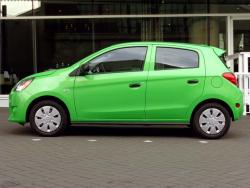 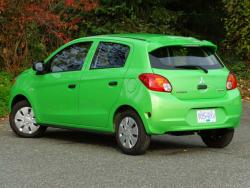 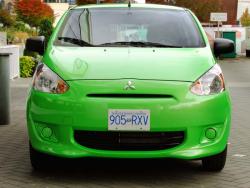 2014 Mitsubishi Mirage ES. Click image to enlarge |
Review and photos by Greg Wilson
Everybody loves a bargain, and on paper at least, the new Mitsubishi Mirage seems like a heck of a deal. Where else can you find a four-door, five-passenger hatchback with average fuel economy of less than 5.0 L/100 km that sells for under $13,000? With a base price of just $12,498 (plus $1,200 delivery charge), the Mirage ES is almost the cheapest car sold in Canada – it’s trumped by the ridiculously cheap $11,898 Nissan Versa 1.6 sedan.
Size-wise, the Mirage is bigger than a Smart Fortwo and smaller than a Toyota Yaris. Its closest competitor is probably the Chevrolet Spark: the Mirage is slightly longer and wider than the Spark but not quite as tall. But though it is small, the Mirage’s “wheels-at-each-corner” design and tall roof allows a surprising amount of cabin space and easy entry through four good-sized doors. And unlike the Spark, which seats only four people, the Mirage can seat five adults. However, the Mirage’s narrow body width means that the rear seat is better suited for two.
Powered by a 74-hp 1.2L three-cylinder motor and mated to a standard five-speed manual transmission or optional continuously variable transmission (CVT), the Mirage is officially rated at 5.9 city/4.6 hwy with the manual transmission (40/51 US mpg); and 5.3 city/4.4 hwy with the CVT (44/54 US mpg). (EPA ratings are 6.9/5.6 or 34/42 US mpg with a manual; CVT – 6.4/5.3 or 37/44 US mpg). That makes the Mirage even more fuel efficient than the tiny Smart Fortwo and Scion iQ. Only hybrids, plug-in hybrids (and electric cars) offer better fuel economy.
Vehicle manufacturers don’t often lend us base models with no options, so we were pleased to have the opportunity to test-drive a no-frills ES trim with the standard five-speed manual transmission. Finished in an eye-catching Kiwi Green exterior colour, we affectionately dubbed our tester, “Kermit”. Personally, I wouldn’t choose bright green, but when I ventured out into the daily chaos of urban traffic, I quickly realized that a bright colour is a great safety feature for a small car: nobody can miss you!
With just 74 horsepower at 6,000 rpm and maximum 74 lb-ft of torque at 4,000 rpm produced from its hard-working 1.2L DOHC 12-valve motor with variable valve timing, the Mirage is definitely a slowpoke – even though it only weighs 895 kg (1,973 lb). Recent AJAC performance tests clocked the Mirage with a CVT from 0 to 100 km/h in 13.2 seconds. That’s definitely slow, but the Chevy Spark is even slower: 0 to 100 km/h in 14.1 seconds!
The engine has so little torque that it’s necessary to downshift when ascending even the slightest grades. Passing on the freeway requires nerves of steel. Not only that, but the Mirage’s three-cylinder engine is noisy and coarse at higher revs, objecting strenuously at any attempt to approach its 6,600 rpm redline. At a steady cruising speed of 100 km/h, the engine turns over 3,000 rpm in fifth gear, higher than average, but necessary to compensate for the engine’s lack of torque.
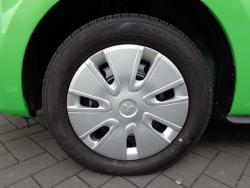 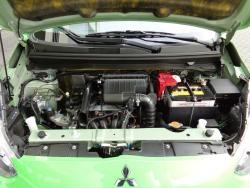 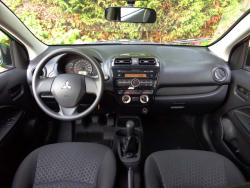 2014 Mitsubishi Mirage ES. Click image to enlarge |
The standard five-speed manual transmission is easy to shift and clutch pedal effort is light, but I found myself slipping the clutch in first gear in order not to stall the engine. The clutch engagement point is high and just touching the clutch pedal with the left foot begins to disengage it. It reminds me of the way cars used to be. One positive note: I was able to achieve around 5.3 L/100 km in city driving by shifting often and early, according to the onboard fuel consumption display.
I briefly drove the Mirage equipped with the CVT and though it is a bit slower than the manual car, it’s probably a better choice for the typical commuter.
At city speeds, the Mirage is a nimble handler – it has a traditional front MacPherson strut/rear torsion beam suspension – but because it is a narrow car with small skinny tires (Dunlop Enersave 165/65R14 all-season), it leans and understeers heavily when pushed to its limits (which aren’t very high). This is one car that could really benefit from its standard electronic stability control. In city driving, its tight turning circle of just 9.2 metres (30.2 ft.) makes it easy to park and maneuver in tight spaces and its electric power rack and pinion steering requires little effort.
Braking performance is sub-par, though. Front disc brakes and rear drum brakes with ABS and Brake Assist are standard, but AJAC braking tests show a 100 km/h to zero braking distance of 46.4 metres (152 ft.) – that’s two metres longer than a Chevrolet Spark.
In the driver’s seat, outward visibility is good, helped by large side windows and a rear window with intermittent wiper, washer and defroster. There’s a good view of the instruments and controls and the shift lever is within easy reach, however the driver’s seat is not height adjustable, the steering wheel tilts but doesn’t telescope, and there is no centre armrest. This could be a problem for drivers with short legs or long arms. There’s plenty of headroom and legroom in the front but the front seats have almost no lateral support when cornering and are increasingly uncomfortable on longer drives. At the rear, there is generous headroom and adequate legroom for two adults, but the rear bench seat cushion and seatbacks are hard and uncomfortable.
    2014 Mitsubishi Mirage ES. Click image to enlarge |
The quality of the base car’s standard black cloth seat fabric, with stylized seat inserts, is fairly good, but the hard plastics on the dash and centre console, the shiny black trim around the centre stack, the old-school LCD radio display, and the sliding levers for the temperature and recirculation functions have a decidedly low-rent appearance. On the plus side, the instrument cluster includes a tachometer and a small display with useful information such as average fuel consumption, distance to empty, trip odometers and a fuel gauge. The centre stack has an AM/FM/CD/MP3 player with large buttons and a centre volume knob, an auxiliary plug-in on the faceplate, and a 12-volt power outlet lower down on the centre stack near an open storage bin. I found the LCD radio display difficult to read in certain light conditions.
   2014 Mitsubishi Mirage ES. Click image to enlarge |
The Mirage ES has power front windows and manual winding rear windows, which are easy to wind down and roll all the way down to the window sill. SE models get standard power rear windows. My biggest beef with the base Mirage is the lack of power door locks and central locking. I’ve become so used to locking and unlocking all the doors with a single push of a button, that I’ve forgotten what a hassle it is to lock and unlock each door individually – as well as the trunk.

























The Mirage’s rear cargo area is easily accessible via a lightweight hatch, but the rear cargo area is comparatively small (235 L w/seats up; 487 w/ seats down). The similarly sized Chevrolet Spark offers 323 and 884 L respectively. As well, the folded seats aren’t level with the cargo floor making it more difficult to slide in longer objects. However, it’s nice to see a removable privacy cover standard on the base model.
For its sub-$13,000 base price, the Mirage ES includes 14-inch tires, seven airbags (including driver’s knee airbag), 140-watt AM/FM/CD/MP3 audio system with four speakers, power front windows, power mirrors, tilt steering wheel, information display with average fuel economy, variable intermittent wipers, rear intermittent wiper and washer, and split folding rear seatbacks. A continuously variable transmission (CVT) is an extra $1,200.
The next trim level, the Mirage SE, starts at $15,398. It adds alloy wheels, front fog lights, automatic climate control (with air conditioning), heated front seats, heated side mirrors, power door locks with remote keyless entry, rear power windows, and six-way height-adjustable driver’s seat. The CVT is $1,200 extra.
For $500 more, you can add the optional Convenience Package with Bluetooth hands-free cell phone, streaming audio, and voice activation; USB port; cruise control; audio and cruise control buttons on the steering wheel; and leather wrapped steering wheel and gear shift knob. With these options, the Mirage SE tops out at just over $17,000, plus $1,200 Freight.
Available exterior colours include InfraRed, Kiwi Green, Plasma Purple, Thunder Grey, Starlight Silver, Sapphire Blue, Cloud White and Mystic Black.
|
Related Articles: Manufacturer’s Website: Photo Gallery: |
Like all Mitsubishis, the Mirage comes with the longest new vehicle warranty available in Canada: a standard 5-year/100,000 km warranty (with roadside assistance) and 10-year/160,000 km powertrain warranty.
Built in Thailand, the Mirage first went on sale last year in Japan followed by the Philippines, Australia, Europe, and now Canada and the U.S. It’s available now at any of Mitsubishi’s 88 Canadian dealers.
Pricing: 2014 Mitsubishi Mirage ES
Base price: $12,498
Options: none
Freight: $ 1,200
Price as tested: $13,698
Competitors:
Chevrolet Spark
Fiat 500
Mazda2
Scion iQ
Toyota Yaris
Crash Test Results:
National Highway Traffic Safety Administration (NHTSA)
Insurance Institute for Highway Safety (IIHS)











